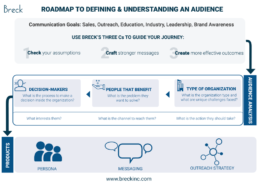
Strategic Communications: Understanding Your Target Audience (Part 2 of 3)
Your messaging, marketing, outreach, and communications strategy is informed by how well you understand your audience. In the first part of our strategic communications Insights series, we discussed how meaningful goals are at the heart of a strategic communications plan. In Part Two, we discuss how understanding your audience and their needs goes hand in hand with your goals and planning.
Defining Your Audience
Who is your audience? If you sell toothpaste, it should not be “everyone who brushes their teeth.” The answer is never “everyone.” As with your marketing and communications goals, the more specific your audience definition, the more effective your plan will be. Audience doesn’t simply mean “customers” either. It can mean a wide range of stakeholders and influencers. Study your strategic communications goals to identify the people you need to reach. Check out our infographic for a roadmap to understanding your audience, which will lead to communications products that serve your greater goals.
Understanding Your Audience
Identification is the first step. Next, research will help you understand your audience and reach them effectively. We’ve written before about personas, portraits of your ideal targeted audience members. Exercise your creativity and understanding to give your persona a name, a job, and a voice. By engaging in the persona exercise, you can fine-tune your strategy.

Areas to research include:
- Demographics: age, gender, region, education. Understanding these factors can determine the language, imagery, and overall strategy.
- Channels: favorite social media channels. For example, you’re more likely to reach parents on Facebook while tech thought leaders may be more likely to engage on Twitter. It may be more appropriate to target senior-level professionals via LinkedIn.
- Behavior: Beyond social media, what are their purchasing habits? What other products do they use? What competitors do they patronize?
- Pain points: We’ve mentioned pain points for professionals before (creating fast proposals for sales staff, for example). But all audiences have pain points and areas of concern that your product or information can remedy.
With this research in mind, you can build your strategic communications plan to better reach these stakeholders, customers, and influencers. Breck’s Three Cs will give you a roadmap to stronger overall communications:
- Check your assumptions
- Craft stronger messages
- Create more effective outcomes
In our next post in this series, we’ll discuss how to put this research to work in developing strategic messaging that reaches your audience. Not sure where to get started with audience understanding? Professionals with marketing and strategic communications expertise can do the legwork to define and understand your audiences.
